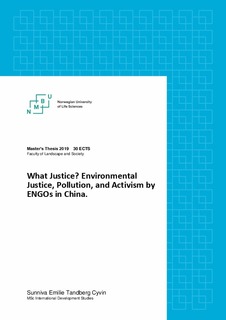| dc.contributor.advisor | Oba, Peter Gufu | |
| dc.contributor.author | Cyvin, Sunniva Emilie Tandberg | |
| dc.coverage.spatial | China | nb_NO |
| dc.date.accessioned | 2019-08-12T11:05:14Z | |
| dc.date.available | 2019-08-12T11:05:14Z | |
| dc.date.issued | 2019 | |
| dc.identifier.uri | http://hdl.handle.net/11250/2607904 | |
| dc.description.abstract | This thesis aims to analyse China’s environmental challenges in relation to environmental policies and environmental justice. The thesis discusses China’s environmental pollution crisis which has been led on by rapid industrialisation, economic development, its large population, and many years of environmental neglect. Such challenges have been handled with varying results, by both policymakers and environmental non-governmental organisations (ENGOs). Heavy pollution in China is generally more concentrated in some areas than in others. The high concentration is usually found rural in areas where people who are already disadvantaged suffer more from environmental injustices, which can be seen through the development of “cancer villages”. The public has in recent years gotten more rights to participate in environmental decision-making. This, in combination with increasing environmental issues, has made the Chinese public shown an increased interest in participating in the improvement of environmental challenges, particularly through ENGOs. This study emphasizes that questionable environmental governance, disinterest, and corruption are the main reasons why environmental clean-up in China has not been as successful as it could have been. The thesis highlights some of the ways in which ENGOs have been successful in making the Chinese government improve their environmental challenges. Further, some of the obstacles to implementing policy and achieving environmental justice (EJ) are described. I argue that environmental justice is a useful concept where Chinese environmental policies are to be considered, as it examines both environmental challenges and social issues. I do so while evaluating how strong EJ is in China today, and how ENGOs have impacted both EJ and environmental policies. | nb_NO |
| dc.language.iso | eng | nb_NO |
| dc.publisher | Norwegian University of Life Sciences, Ås | nb_NO |
| dc.rights | Attribution-NonCommercial-NoDerivatives 4.0 Internasjonal | * |
| dc.rights.uri | http://creativecommons.org/licenses/by-nc-nd/4.0/deed.no | * |
| dc.subject | Environmental justice | nb_NO |
| dc.subject | Chinese environmental policy | nb_NO |
| dc.subject | ENGO | nb_NO |
| dc.subject | Pollution | nb_NO |
| dc.subject | Climate change | nb_NO |
| dc.title | What justice? : environmental justice, pollution, and activism by ENGOs in China | nb_NO |
| dc.type | Master thesis | nb_NO |
| dc.description.version | submittedVersion | nb_NO |
| dc.subject.nsi | VDP::Social science: 200 | nb_NO |
| dc.subject.nsi | VDP::Humanities: 000 | nb_NO |
| dc.source.pagenumber | 72 | nb_NO |
| dc.description.localcode | M-DS | nb_NO |

